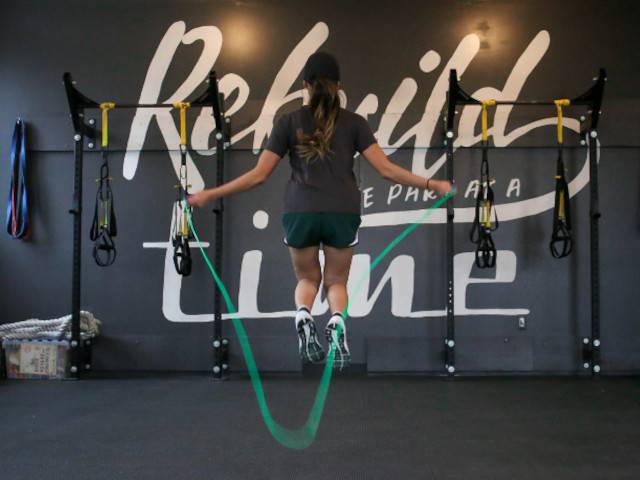Beginner's Guide To Aerobic Exercise

What Is Aerobic Exercise: The Ultimate Beginner's Guide To Cardio Training
Ever experienced climbing a flight of stairs and almost immediately, finding yourself catching your breath? Or, you just find moving around too taxing? Well, a good dose of cardio training is what you might need.
Cardio training, in a nutshell, is strengthening your cardiovascular condition. Although its etymology is different, it shares the same principles as aerobic exercise. The term aerobic pertains to oxygen intake, which is what cardio training exactly does. As you heighten your respiratory rate by moving muscles, your heart pumps blood at a faster rate, hence raising your oxygen capacity as well. It is also what differentiates it from other types of exercise like strength training or balance exercises. If you want to know more about an active lifestyle, Total Shape is an abundant source of tips and know-how.
Benefits of Cardio Training
Aerobic exercise primarily strengthens your heart muscles for less work pumping blood. It also expands your lung capacity allowing for more energy and endurance. An active lifestyle helps burn fats and calories, especially when paired with a proper nutrition plan. This activeness also promotes better blood circulation, leading to healthier skin. As a result of these health benefits, it minimizes the risk of related severe illnesses such as heart attack, diabetes, and some forms of cancer.
Aside from your physiological well-being, it helps improve your mood and self-image as well. You will achieve a fit form with exercise, but activeness also releases stress-reducing hormones such as serotonin, endorphin, and dopamine. It reduces the risk of anxiety, depression, and even dementia. Being active also helps with sleep, encouraging REM sleep and dozing off faster.
Studies have shown that it also has a positive impact on the sexual functions of both women and men. Erectile dysfunction is usually related to circulatory issues. Hence, aerobic exercise lowers the risk of impotence in men. An increase in sexual arousal, both short and long-term, was also observed physically.
Types of Aerobic Exercise
According to the U.S. Department of Health and Human Services, aerobic exercises consist of three components. The first one is intensity, which pertains to the physical effort exerted in doing an activity. Then there is frequency, or how often you do an exercise. And the last one is duration which pertains to how long an activity lasts in a single cycle. These factors you have to consider when you are just about to start.
Another important consideration is choosing activities you personally enjoy. Like how the previous factors should fit your capacity, you have to pick exercises that suit your interests and lifestyle. It makes it easier for you to stick with your routine. If you're more of an outdoor person, you might have fun running, cycling, or walking. If you like having the help of equipment, you can opt for stationary bikes, treadmills, elliptical trainers, and rowing machines.
If you are a homebody or simply can't go outside, you can still do cardio training at home. For simple exercises, you can do jumping rope, jogging place or burpees. If you have money to spare, you can get your own elliptical machine or treadmill. If you need visual guides, videos and mobile apps are widely available. An example of this is aerobics, a rhythmic variation usually accompanied by music. Apart from cardio conditioning, you also get to improve your muscular strength and flexibility. It is usually held in a class led by an instructor, but you can always follow a recorded session.
Duration
According to the Physical Activity Guidelines for Americans, adults should ideally do 150 minutes of moderate-intensity or 75 minutes of vigorous-intensity aerobic exercise in a week. If your goal is to lose weight, 300 minutes of moderate-intensity physical activity will make you shed off five percent of your body weight. It may seem a lot, but if you break it up into the days of the week, it will be easier to achieve.
However, some may still find this duration overwhelming. Hence, you can start with a 10 to 15-minute repetition. Once you feel your body has adjusted, you can increase your routine by 5 minutes. Achieve this gradual increase until you reach a standard of 30 to 60-minute sessions.
Frequency
Figuring out how often to do your cardio training is subjective to every person. It is tailored around your baseline fitness, goals, and schedule. It will also depend on the intensity of your chosen activity. For instance, you can do light to moderate-intensity exercises daily. This is ideal for beginners or those who don't have much time to spare. For high-intensity training, it is advisable to have rest days between your routines.
A 30-minute moderate-intensity routine a day, for 5 days a week, is ideal for your general health. If you have less time, a 20-minute vigorously-intense workout a day, 3 days a week, can substitute for that. If you're at a healthy weight and want to maintain it, 150 to 300 minutes of moderate-intensity workout in a week will be enough. Anything more than 300 minutes of moderate-intensity activity a week will most likely cause weight loss.
You also have to make sure that you are not doing too much. It can cause negative effects on your functioning rather than help you. So, keep your routines achievable and take rest days when your body needs to.
Intensity
You can start playing with your exercise intensity once your body has adjusted. The intensity affects the goals and results of your activity. It is related to how many calories you burn and the amount of time you achieve this. Just like frequency, your intensity level is based on different factors like fitness level and your goals. There are three standard levels of intensity, and it is possible to integrate all of these into your workout routine.
To understand these three levels, you must be familiar with your maximum heart rate or MHR first. It refers to the fastest rate where your heart will beat in a minute. Take note that this is not a gauge of physical fitness. It will, however, aid in figuring out your target heart rate and the appropriate exercise intensity.
The Fox formula is commonly used to measure MHR, which is essentially 220 minus your age. The resulting number is the maximum amount of beats your heart will make in a minute. However, your MHR decreases overtime. It is also different between the sexes and physical size. Hence, there is no accurate gauge unless you are in a controlled laboratory setting. So the ideal solution is making an informed estimate.
The first level of intensity is low-intensity cardio, which is 50% of your MHR. It is usually the level you're at during warm-ups or other day-to-day activities such as brisk walking. The next one is moderate-intensity, which sits at 50% to 70% of your MHR. It is the typical level of intensity for your workouts and the recommended intensity level too. The last one is high-intensity cardio which is somewhere between 70% and 85% of your MHR. At this level, you may only be able to say a word or two before catching your breath. Since it's the most intense, it might pose a bit of a challenge, especially for beginners. Hence, starting with intervals might make it easier, such as the popular HIIT or high-intensity interval training.
Final Tips
When you are just about to set up a workout routine, it is best to stick with an achievable schedule. Not only does your body need time to adjust, but your mind needs conditioning as well. Another way of preventing physical shock is by introducing a 5-10 minute warm-up and cool-down. Stretching or a light cardio routine will help your muscles to be more flexible.
There are also ways you can improve your workout experience. Have the right gear on, such as light sport shoes or breathable exercise clothes. Once you have gotten used to your routine, you can start changing things up. You can add a new exercise, heighten the intensity, or increase the duration. And remember not to push yourself. If you feel sore or sickly, avoid forcing yourself to exercise. All these workouts would not be healthy if you also do not take care of your body. Hence, stick to a healthy diet and be always hydrated. You know your body best, so listen to what it needs.
Cardio training, in a nutshell, is strengthening your cardiovascular condition. Although its etymology is different, it shares the same principles as aerobic exercise. The term aerobic pertains to oxygen intake, which is what cardio training exactly does. As you heighten your respiratory rate by moving muscles, your heart pumps blood at a faster rate, hence raising your oxygen capacity as well. It is also what differentiates it from other types of exercise like strength training or balance exercises. If you want to know more about an active lifestyle, Total Shape is an abundant source of tips and know-how.
Benefits of Cardio Training
Aerobic exercise primarily strengthens your heart muscles for less work pumping blood. It also expands your lung capacity allowing for more energy and endurance. An active lifestyle helps burn fats and calories, especially when paired with a proper nutrition plan. This activeness also promotes better blood circulation, leading to healthier skin. As a result of these health benefits, it minimizes the risk of related severe illnesses such as heart attack, diabetes, and some forms of cancer.
Aside from your physiological well-being, it helps improve your mood and self-image as well. You will achieve a fit form with exercise, but activeness also releases stress-reducing hormones such as serotonin, endorphin, and dopamine. It reduces the risk of anxiety, depression, and even dementia. Being active also helps with sleep, encouraging REM sleep and dozing off faster.
Studies have shown that it also has a positive impact on the sexual functions of both women and men. Erectile dysfunction is usually related to circulatory issues. Hence, aerobic exercise lowers the risk of impotence in men. An increase in sexual arousal, both short and long-term, was also observed physically.
Types of Aerobic Exercise
According to the U.S. Department of Health and Human Services, aerobic exercises consist of three components. The first one is intensity, which pertains to the physical effort exerted in doing an activity. Then there is frequency, or how often you do an exercise. And the last one is duration which pertains to how long an activity lasts in a single cycle. These factors you have to consider when you are just about to start.
Another important consideration is choosing activities you personally enjoy. Like how the previous factors should fit your capacity, you have to pick exercises that suit your interests and lifestyle. It makes it easier for you to stick with your routine. If you're more of an outdoor person, you might have fun running, cycling, or walking. If you like having the help of equipment, you can opt for stationary bikes, treadmills, elliptical trainers, and rowing machines.
If you are a homebody or simply can't go outside, you can still do cardio training at home. For simple exercises, you can do jumping rope, jogging place or burpees. If you have money to spare, you can get your own elliptical machine or treadmill. If you need visual guides, videos and mobile apps are widely available. An example of this is aerobics, a rhythmic variation usually accompanied by music. Apart from cardio conditioning, you also get to improve your muscular strength and flexibility. It is usually held in a class led by an instructor, but you can always follow a recorded session.
Duration
According to the Physical Activity Guidelines for Americans, adults should ideally do 150 minutes of moderate-intensity or 75 minutes of vigorous-intensity aerobic exercise in a week. If your goal is to lose weight, 300 minutes of moderate-intensity physical activity will make you shed off five percent of your body weight. It may seem a lot, but if you break it up into the days of the week, it will be easier to achieve.
However, some may still find this duration overwhelming. Hence, you can start with a 10 to 15-minute repetition. Once you feel your body has adjusted, you can increase your routine by 5 minutes. Achieve this gradual increase until you reach a standard of 30 to 60-minute sessions.
Frequency
Figuring out how often to do your cardio training is subjective to every person. It is tailored around your baseline fitness, goals, and schedule. It will also depend on the intensity of your chosen activity. For instance, you can do light to moderate-intensity exercises daily. This is ideal for beginners or those who don't have much time to spare. For high-intensity training, it is advisable to have rest days between your routines.
A 30-minute moderate-intensity routine a day, for 5 days a week, is ideal for your general health. If you have less time, a 20-minute vigorously-intense workout a day, 3 days a week, can substitute for that. If you're at a healthy weight and want to maintain it, 150 to 300 minutes of moderate-intensity workout in a week will be enough. Anything more than 300 minutes of moderate-intensity activity a week will most likely cause weight loss.
You also have to make sure that you are not doing too much. It can cause negative effects on your functioning rather than help you. So, keep your routines achievable and take rest days when your body needs to.
Intensity
You can start playing with your exercise intensity once your body has adjusted. The intensity affects the goals and results of your activity. It is related to how many calories you burn and the amount of time you achieve this. Just like frequency, your intensity level is based on different factors like fitness level and your goals. There are three standard levels of intensity, and it is possible to integrate all of these into your workout routine.
To understand these three levels, you must be familiar with your maximum heart rate or MHR first. It refers to the fastest rate where your heart will beat in a minute. Take note that this is not a gauge of physical fitness. It will, however, aid in figuring out your target heart rate and the appropriate exercise intensity.
The Fox formula is commonly used to measure MHR, which is essentially 220 minus your age. The resulting number is the maximum amount of beats your heart will make in a minute. However, your MHR decreases overtime. It is also different between the sexes and physical size. Hence, there is no accurate gauge unless you are in a controlled laboratory setting. So the ideal solution is making an informed estimate.
The first level of intensity is low-intensity cardio, which is 50% of your MHR. It is usually the level you're at during warm-ups or other day-to-day activities such as brisk walking. The next one is moderate-intensity, which sits at 50% to 70% of your MHR. It is the typical level of intensity for your workouts and the recommended intensity level too. The last one is high-intensity cardio which is somewhere between 70% and 85% of your MHR. At this level, you may only be able to say a word or two before catching your breath. Since it's the most intense, it might pose a bit of a challenge, especially for beginners. Hence, starting with intervals might make it easier, such as the popular HIIT or high-intensity interval training.
Final Tips
When you are just about to set up a workout routine, it is best to stick with an achievable schedule. Not only does your body need time to adjust, but your mind needs conditioning as well. Another way of preventing physical shock is by introducing a 5-10 minute warm-up and cool-down. Stretching or a light cardio routine will help your muscles to be more flexible.
There are also ways you can improve your workout experience. Have the right gear on, such as light sport shoes or breathable exercise clothes. Once you have gotten used to your routine, you can start changing things up. You can add a new exercise, heighten the intensity, or increase the duration. And remember not to push yourself. If you feel sore or sickly, avoid forcing yourself to exercise. All these workouts would not be healthy if you also do not take care of your body. Hence, stick to a healthy diet and be always hydrated. You know your body best, so listen to what it needs.
MORE





